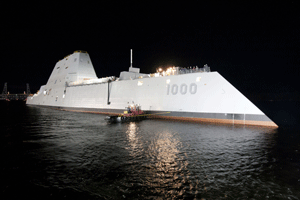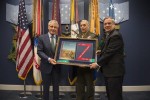This will be one of my briefest articles, but a couple of things have compelled me to write about service, sacrifice and the luxury of choice. First and foremost on my mind is the upcoming Veterans Day, a national tradition dating back to November 11th, 1918. The end of the “War to end all Wars”, marked by a cessation of hostilities between German and Allied forces, was put into force on “the eleventh hour of the eleventh day of the eleventh month.” When President Wilson declared Armistice Day to be observed beginning in 1919, his intent was to have nationwide parades and events at 11AM on November 11th. The Congress eventually formalized Veterans Day in 1938, when it was declared that this date would be a time to honor American veterans of all wars. There was a time in the 60’s when there was a push for the big Federal Holidays (Washington’s Birthday, Memorial Day, Veterans Day, and Columbus Day) to occur on Mondays, allowing for three-day weekends to encourage “travel, recreational and cultural activities and stimulate greater industrial and commercial production,” but it was confusing and in the end Veterans Day moved back to November 11th in 1978. I don’t know if Wikipedia is the final authoritative source on Veterans Day, but according to Wiki, the purpose of Veterans Day as we now celebrate it is to “honor America’s veterans for their patriotism, love of country, and willingness to serve and sacrifice for the common good.”
“I do solemnly swear or affirm (as the case may be) to bear true faith and allegiance to the United States of America, and to serve them honestly and faithfully against all their enemies or opposers whatsoever, and to observe and obey the orders of the president of the United States of America, and the orders of officers appointed over me.” 1789 Oath of Enlistment
While many veterans who served before 1973 may have been drafted and therefore not necessarily “volunteers” they still certainly sacrificed much in service to America. And many indeed volunteered to serve, even during the period when the draft was in effect. Since 1973 we have been an all-volunteer force and except for a few lean years, the Services haven’t had much trouble in filling enlistment quotas. I marvel at the extraordinary sacrifices our active duty, guard and reserve men and women in uniform make every day: risk to life in conflicts, separation from family and friends, careers put on hold, dangers at work, and countless others sacrifices that only they know. So I am proud to be among their number, although I am mindful that many have sacrificed so much more than I. They will be on my mind this upcoming Veterans Day. If you are looking for a way to honor those who have sacrificed much, there are many options….go to a Parade, give a homeless vet food and shelter, donate to a veteran-focused charity, etc. But for me, please don’t say “Thank you for your service.” As far as I’m concerned that’s a mindless phrase, a cop-out which allows one to feel good without having to commit anything. It’s expected and akin to saying “Bless You” after a sneeze. They are words spoken without commitment or consciousness by many who utter them. I would much rather hear, “I never served, but as a way of showing my gratitude for those who did, I work with homeless veterans at the local shelter”, or maybe, “Where did you serve and what did you do?” That shows interest not a clever, trendy reflex. And I would be OK with a “Thank you for your commitment America. I am grateful for your service.” At least put some thought and feeling in it!
“I do solemnly swear (or affirm) that I will support and defend the Constitution of the United States against all enemies, foreign and domestic; that I will bear true faith and allegiance to the same; and that I will obey the orders of the president of the United States and the orders of the officers appointed over me, according to regulations and the Uniform Code of Military Justice. So help me God..” Current Oath of Enlistment
I said I was going to be brief, so I better wrap up..The other event on my mind was the recent election of Representative Paul Ryan as Speaker of the House. I certainly wouldn’t want that job. But I was struck with his “demands” and how they contrast with the service our veterans rendered to our nation. They didn’t get an opportunity to bargain for weekends off to be with family or to say “I will serve, but only in CONUS.” Seems to me that he’s only going to be Speaker for a few years (probably less time than the average enlistment contract), so suck it up! Remember all those who don’t get a chance to spend weekends with their families while being shot at……a far cry from dangerous caucuses or risky debates in the halls of Congress. So it must be nice to have the luxury of choice and get credit for service without too much sacrifice as so many on the Hill are wont to do. I guess that explains why there is no “Congress Day” on our national calendar.
Here’s a way to honor our Veterans this year. Attend the Navy Safe Harbor Foundation Veterans Day luncheon at the Army Navy Country Club at the 11th Hour of the 11 Day of the 11th month: Click here to register.


 It’s the world where everything is backwards….the name of the bizarro world planet is Htrae (so clever!) and the world is square. As I recall, it was featured occasionally in Superman comics in the 1960’s. One of the mottos in Bizarro World was ” Us do opposite of all earthly things.” Bizarro bonds were a hot item on Htrae because they were “guaranteed to lose money.” So I don’t think it’s a huge stretch to make the analogy here.
It’s the world where everything is backwards….the name of the bizarro world planet is Htrae (so clever!) and the world is square. As I recall, it was featured occasionally in Superman comics in the 1960’s. One of the mottos in Bizarro World was ” Us do opposite of all earthly things.” Bizarro bonds were a hot item on Htrae because they were “guaranteed to lose money.” So I don’t think it’s a huge stretch to make the analogy here. A few days after the decision was made, the staff came back and noted that since we slid the ship a year, it’s going to cost more…..I don’t remember how much, but it was around $100 Million or so. “Really?” I commented. ‘Oh, yes,” came the reply, ” money will cost more the next year, we have shipyard loading issues that we will have to pay for, the cost of steel is going up, blah, blah blah.” So I began to understand that the economics of shipbuilding were different. I formulated The Shipbuilding Entropy Rule: “Nothing ever costs less. NO matter what you do, it will always cost more.” You buy less, they cost more. You cancel the buy, you still have to pay the overhead. You remove capability, it costs more to redo drawings. Its all very counter-intuitive. This became very clear to me during the following year’s budget build when the staff came back and said “We made a mistake. We have to move the LMSR back to the original purchase year.” “Fine,” I replied, “No harm, no foul.” Sensing it wasn’t “Fine“, based on the furtive glances between the staffers (an admiral sees a lot of those looks in the Pentagon) I asked “What’s wrong?” Turns out, if we moved the ship back into the original purchase year, it added another $100 Million to the cost! Whadakknow? We essentially did nothing and paid $200 Million not to do it! That, my friends, is Bizarro accounting!
A few days after the decision was made, the staff came back and noted that since we slid the ship a year, it’s going to cost more…..I don’t remember how much, but it was around $100 Million or so. “Really?” I commented. ‘Oh, yes,” came the reply, ” money will cost more the next year, we have shipyard loading issues that we will have to pay for, the cost of steel is going up, blah, blah blah.” So I began to understand that the economics of shipbuilding were different. I formulated The Shipbuilding Entropy Rule: “Nothing ever costs less. NO matter what you do, it will always cost more.” You buy less, they cost more. You cancel the buy, you still have to pay the overhead. You remove capability, it costs more to redo drawings. Its all very counter-intuitive. This became very clear to me during the following year’s budget build when the staff came back and said “We made a mistake. We have to move the LMSR back to the original purchase year.” “Fine,” I replied, “No harm, no foul.” Sensing it wasn’t “Fine“, based on the furtive glances between the staffers (an admiral sees a lot of those looks in the Pentagon) I asked “What’s wrong?” Turns out, if we moved the ship back into the original purchase year, it added another $100 Million to the cost! Whadakknow? We essentially did nothing and paid $200 Million not to do it! That, my friends, is Bizarro accounting! They became so expensive and the requirements bounced around so much, we began advertising it as a fire support ship vital to the survival of the Marines during amphibious assaults. As such, we only needed about 10-12, just enough to support the number of amphibious ready groups (ARGS) we had at the time. The Marines were happy about that, even though they preferred to have 2 per ARG. I even went over to the Hill with my Marine counterpart extolling the virtues of the DDG-21 as the perfect fire support ship for the Marines. But once the Marines realized that the cost of the ship was so high that it would probably limit the amount of other stuff they could buy, they dropped it like a hot potato…..they would much rather have the 360 V-22’s than 24 DD(X)’s. So in the space of about a month we changed our tune from”vital” to “not so vital.” Now that they are $3 Billion a copy, we are only building 3 of them and I’m not sure there’s a real requirement out there. As my Grandmother said when she got her first taste of champagne in one of those dinky champagne flutes at my son’s baptism, “That’s not enough to wet my whistle.” So it is with DDG-1000 IMHO. The real requirement as far as I can tell is to have something for Bath Iron Works to build ( they will build all three) so they can stay in business in order to address industrial base concerns. Hence the title of the article.
They became so expensive and the requirements bounced around so much, we began advertising it as a fire support ship vital to the survival of the Marines during amphibious assaults. As such, we only needed about 10-12, just enough to support the number of amphibious ready groups (ARGS) we had at the time. The Marines were happy about that, even though they preferred to have 2 per ARG. I even went over to the Hill with my Marine counterpart extolling the virtues of the DDG-21 as the perfect fire support ship for the Marines. But once the Marines realized that the cost of the ship was so high that it would probably limit the amount of other stuff they could buy, they dropped it like a hot potato…..they would much rather have the 360 V-22’s than 24 DD(X)’s. So in the space of about a month we changed our tune from”vital” to “not so vital.” Now that they are $3 Billion a copy, we are only building 3 of them and I’m not sure there’s a real requirement out there. As my Grandmother said when she got her first taste of champagne in one of those dinky champagne flutes at my son’s baptism, “That’s not enough to wet my whistle.” So it is with DDG-1000 IMHO. The real requirement as far as I can tell is to have something for Bath Iron Works to build ( they will build all three) so they can stay in business in order to address industrial base concerns. Hence the title of the article.